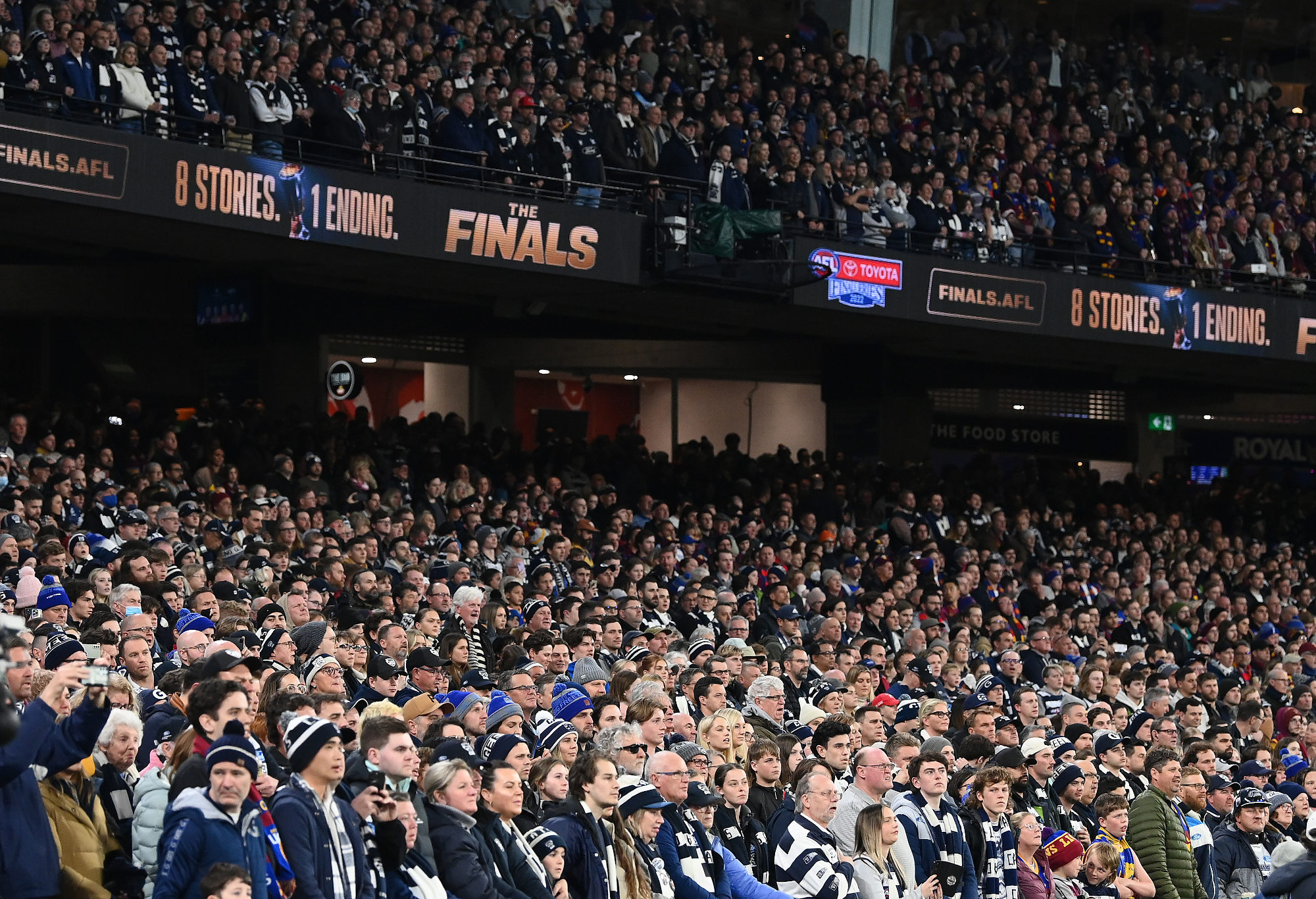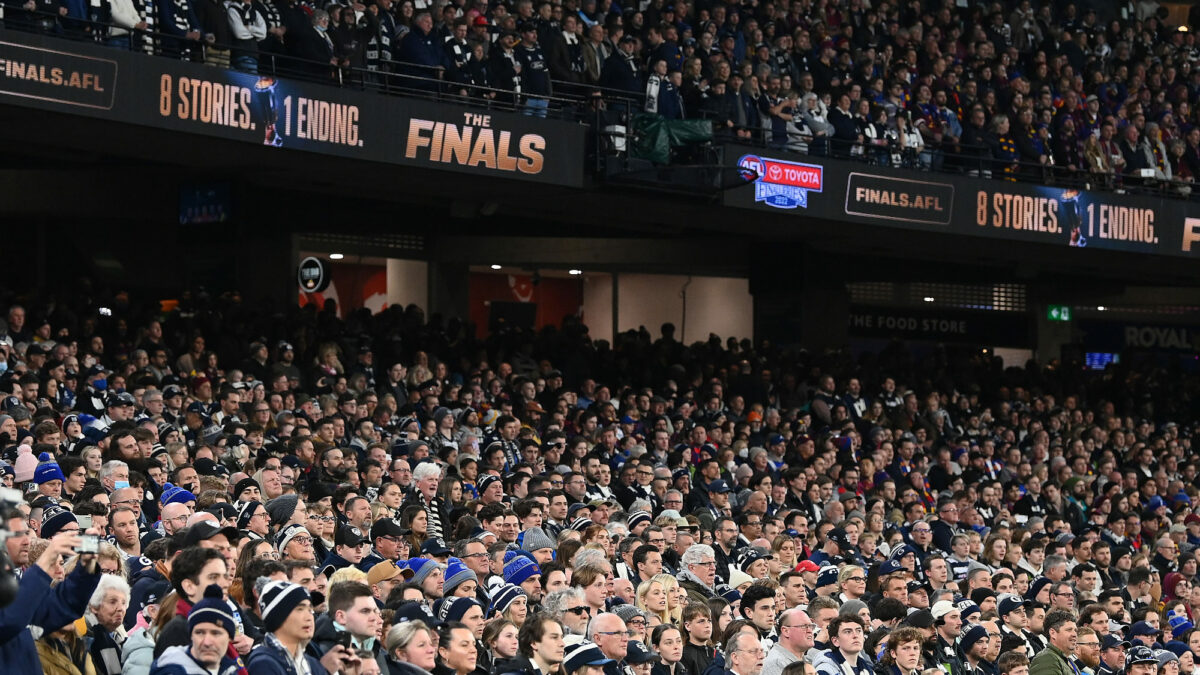Packed Richmond pubs. Record sellers being gang tackled. Heaving queues just to get in the gate. Pop-up pubs in Yarra Park. Noise.
A mass of footy-mad humanity.
Perhaps it was the scarcity of Melbourne finals in the previous fortnight, but the weekend’s two MCG preliminary finals felt just as big as the last day in September.
The numbers back this up.
Nobody was terribly shocked at 99,567 and 96,023 people lobbing at the ‘G, but when you zoom back and analyse the trends, the hold the grand final has over Melbourne’s population has extended to become a whole finals series-long hex.
Since 2017, and over only seven seasons given the 2020 and 2021 finals series were shifted outside Melbourne, we have had 18 90,000 plus crowds at finals at the MCG, not including the big dance.
For the seven seasons prior to 2017 that make up the rest of the 2010s, there were only four 90,000 plus crowds at non-Grand Final MCG Finals.
The visceral experience, and lasting memory, of being at a big final in the current era is now something that was once solely reserved for the grand final.
In a year where a lot has gone wrong, credit needs to go to the AFL for the slow burn creation of the finals as a stand-alone national proposition rather than just the Grand Final as the jewel in the crown.
Compare the boiling point rivalry that attracted 99,567 to the Geelong v Hawthorn Preliminary to the just 44,709 that attended an Elimination Final between the teams at Docklands in 2000 to see how far we’ve come.
As it’s not just Melbourne that has finals fever.
In a September that saw matches played in five states, and involved teams from seven cities, finals this year have all been played before more than an 86 per cent crowd capacity.
Even GWS filled 87.8 per cent of ENGIE Stadium for their elimination final.
Improvements in stadium comfort and facilities across the country have played a major role in getting people motivated to spend their hard earned time and money (tickets have not stayed cheap) on football.
The national spread of the game has meant Victorian clubs and the MCG have not got the divine right to finals it did in decades past.
If you blink, you might not get that chance for some time – witness the crowd lifts with the deep revival finals runs of Richmond (2017), Melbourne (2018) and Carlton (2023).
Almost laughably, you can even include a just five-year finals-dormant Hawthorn into that basket over the past two seasons.
An increase in club membership figures with finals access as a major carrot has created a ritual for fans, where you would be wasting a year-long investment not to get those September tickets.

Crowds at the MCG. (Photo by Quinn Rooney/Getty Images)
Similarly, the increase in member numbers and tightening up of processes (to the chagrin of some) for MCC and AFL membership ticket access has further driven demand. Where once an MCC member could decide on game day morning whether to attend and still expect a seat, today they need to jump online with club members and commit on Monday.
The sophistication of online ticketing (an oxymoron for some, I’m sure) has allowed greater capacity to ensure more seats are filled. We are now conditioned to the ticket scramble culture – footy finals are no different to refreshing your browser for Taylor Swift or Oasis.
Like the Australian Open or the Melbourne Grand Prix, the entire AFL finals series is now in the always sellable category.
Social media has undeniably played a part in that development – are you really part of popular culture if you didn’t post to Tik Tok or Instagram from an AFL final this year?
Credit must also be given to the AFL for attempting to make September a more inclusive experience for the masses. After a bunch of false starts (does anyone remember the 1990s AFL Sensation?), their MCG Footy Fest has hit the mark by giving families a taste of the grand final when they’re unlikely to get a ticket.
In concert with a steady diet of free child-friendly community activities through September, greater inclusivity and excitement has been built.
It has resulted in finals becoming the new grand final; and it also means the MCG finding some way to increase capacity when the Shane Warne Stand is rebuilt in the coming years is not as silly as once thought.
It comes at a crucial time for the AFL, who for the first time in a while, will be in unchartered waters going into 2026, having to deal with with a faltering free-to-air television market, a once-cable but now-streaming provider sold to a company without any historical connection to the game, and a bunch of other streamers who operate globally rather than nationally.
At an AFL industry conference on the Gold Coast in 2010, ahead of the Suns/Giants expansion, an NBA executive talked extensively of how empty seats were a cancer for broadcasters. Sure, television ratings may be the numbers that mattered most to rights holders, but those visible vacant stands conveys something intrinsically to sports fans. If there is nobody attending, why am I bothering to watch it?
That’s what the AFL has in spades over the NRL as it faces off for the next rights cash grab, despite what the close, but increasingly anachronistic, television ratings numbers say.
The development of finals as the ‘new grand final’ will be on show when Brisbane take on Geelong this weekend.
Once upon a time, this match-up would have been seen as being between two small market teams; in 2004 they drew 55,000 to an MCG preliminary final, and that was seen as a good result.
Not anymore.
The two best teams of their generation will square off after a string of finals in recent years where crowds have been increasing, to the point of 93,006 for last year’s preliminary final and 86,364 for a qualifying final mere weeks ago.
Memorable matches and memorable grand final-esque crowds both; now we get the real thing.
There won’t be a spare seat in the house on Saturday. But there’s barely been one all September anyway.

